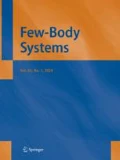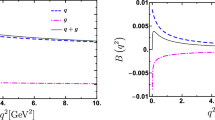Abstract
The Weinberg operator (chromo-electric dipole moment of gluon) is a CP violating quantity generated in many candidates of new physics beyond the standard model, and it contributes to observables such as the electric dipole moments (EDM) of the neutron or atoms which are currently measured in experiments. In this proceedings contribution, we report on our result of the evaluation of the Weinberg operator contribution to the nucleon EDM in the nonrelativistic quark model using the Gaussian expansion method.



Similar content being viewed by others
References
A.D. Sakharov, Violation of CP invariance, C asymmetry, and Baryon asymmetry of the universe. Pisma Zh. Eksp. Teor. Fiz. 5, 32 (1967)
A.D. Sakharov, Violation of CP invariance, C asymmetry, and Baryon asymmetry of the universe. JETP Lett. 5, 24 (1967)
M. Kobayashi, T. Maskawa, CP violation in the renormalizable theory of weak interaction. Prog. Theor. Phys. 49, 652 (1973)
P. Huet, E. Sather, Electroweak baryogenesis and standard model CP violation. Phys. Rev. D 51, 379 (1995)
N. Yamanaka, Analysis of the Electric Dipole Moment in the R-Parity Violating Supersymmetric Standard Model (Springer, Berlin, 2014).
N. Yamanaka, B.K. Sahoo, N. Yoshinaga, T. Sato, K. Asahi, B.P. Das, Probing exotic phenomena at the interface of nuclear and particle physics with the electric dipole moments of diamagnetic atoms: A unique window to hadronic and semi-leptonic CP violation. Eur. Phys. J. A 53, 54 (2017)
T. Chupp, P. Fierlinger, M. Ramsey-Musolf, J. Singh, Electric dipole moments of atoms, molecules, nuclei, and particles. Rev. Mod. Phys. 91, 015001 (2019)
S. Weinberg, Larger Higgs exchange terms in the neutron electric dipole moment. Phys. Rev. Lett. 63, 2333 (1989)
I.I.Y. Bigi, N.G. Uraltsev, Induced multi-gluon couplings and the neutron electric dipole moment. Nucl. Phys. B 353, 321 (1991)
I.I.Y. Bigi, N.G. Uraltsev, Effective gluon operators and the dipole moment of the neutron. Zh. Eksp. Teor. Fiz. 100, 363 (1991)
I.I.Y. Bigi, N.G. Uraltsev, Effective gluon operators and the dipole moment of the neutron. Sov. Phys. JETP 73, 198 (1991)
M.E. Pospelov, CP odd effective gluonic Lagrangian in the Kobayashi–Maskawa model. Phys. Lett. B 328, 441 (1994)
Y. Yamaguchi, N. Yamanaka, Quark level and hadronic contributions to the electric dipole moment of charged leptons in the standard model. Phys. Rev. D 103, 013001 (2021)
C. Abel et al., Measurement of the permanent electric dipole moment of the neutron. Phys. Rev. Lett. 124, 081803 (2020)
J. Dragos, T. Luu, A. Shindler, J. de Vries, A. Yousif, Confirming the existence of the strong CP problem in lattice QCD with the gradient flow. Phys. Rev. C 103, 094004 (2021)
M.D. Rizik et al., Short flow-time coefficients of \(CP\)-violating operators. Phys. Rev. D 102, 136126 (2020)
Y. Hatta, \(CP\)-odd gluonic operators in QCD spin physics. Phys. Rev. D 102, 015007 (2020)
Y. Hatta, Nucleon electric dipole moment from polarized deep inelastic scattering. Phys. Lett. B 814, 154 (2021)
D.A. Demir, M. Pospelov, A. Ritz, Hadronic EDMs, the Weinberg operator, and light gluinos. Phys. Rev. D 67, 223 (2003)
U. Haisch, A. Hala, Sum rules for CP-violating operators of Weinberg type. JHEP 11, 154 (2019)
E. Hiyama, Y. Kino, M. Kamimura, Gaussian expansion method for few-body systems. Prog. Part. Nucl. Phys. 51, 223 (2003)
N. Yamanaka, E. Hiyama, Enhancement of the CP-odd effect in the nuclear electric dipole moment of \(^6\)Li. Phys. Rev. C 91, 065503 (2015)
N. Yamanaka, E. Hiyama, Standard model contribution to the electric dipole moment of the deuteron, \(^{3}\)H, and\(^{3}\)He nuclei. JHEP 02, 067 (2016)
N. Yamanaka, T. Yamada, E. Hiyama, Y. Funaki, Electric dipole moment of \(^{13}\)C. Phys. Rev. C 95, 1730002 (2017)
N. Yamanaka, Electric dipole moment of the deuteron in the standard model with NN \(-\Lambda \) N \(-\Sigma \) N coupling. Nucl. Phys. A 963, 33 (2017)
N. Yamanaka, Review of the electric dipole moment of light nuclei. Int. J. Mod. Phys. E 26, 1730002 (2017)
J. Lee, N. Yamanaka, E. Hiyama, Effect of the Pauli exclusion principle in the electric dipole moment of \(^9\)Be with \(|\varDelta \, S|=1\) interactions. Phys. Rev. C 99, 055503 (2019)
N. Yamanaka, T. Yamada, Y. Funaki, Nuclear electric dipole moment in the cluster model with a triton: \(^7\)Li and \(^{11}\)B. Phys. Rev. C 100, 055501 (2019)
N. Yamanaka, E. Hiyama, Weinberg operator contribution to the nucleon electric dipole moment in the quark model. Phys. Rev. D 103, 035023 (2021)
R.K. Bhaduri, L.E. Cohler, Y. Nogami, A unified potential for mesons and baryons. Nuovo Cim. A 65, 376 (1981)
C. Semay, B. Silvestre-Brac, Diquonia and potential models. Z. Phys. C 61, 271 (1994)
A.F. Falcão, O. Oliveira, P.J. Silva, Analytic structure of the lattice Landau gauge gluon and ghost propagators. Phys. Rev. D 102, 114518 (2020)
P. Froese, P. Navratil, Ab initio calculations of electric dipole moments of light nuclei, arXiv:2103.06365 [nucl-th]
Author information
Authors and Affiliations
Corresponding author
Additional information
Publisher's Note
Springer Nature remains neutral with regard to jurisdictional claims in published maps and institutional affiliations.
Rights and permissions
About this article
Cite this article
Yamanaka, N., Hiyama, E. Quark Model Analysis of the Weinberg Operator Contribution to the Nucleon EDM. Few-Body Syst 62, 27 (2021). https://doi.org/10.1007/s00601-021-01611-6
Received:
Accepted:
Published:
DOI: https://doi.org/10.1007/s00601-021-01611-6



